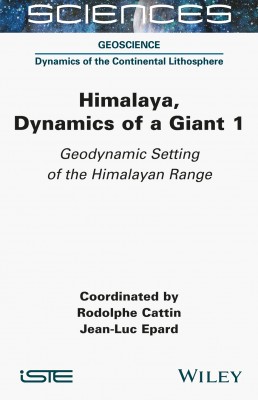
The Himalaya is well known as the largest and highest mountain belt on Earth. Advances in geoscience over the past few decades have revealed a complex picture of the dynamics of this giant, opening up questions about the initial stages of Himalayan building, lateral variations in its structures, variations in tectonic forcing, tectonic-climate coupling and assessments of the natural hazards affecting this area.
In this three-volume book, we present the current knowledge on the building and present-day behavior of the Himalayan range. The objective is not to be exhaustive, but to provide some key elements used by researchers to unravel the many processes acting in the Himalayan dynamics.
Mountain environments are at the forefront of climate change with glacier retreat, landslides, flash floods and water availability. Understanding the delicate balance that controls the dynamics of the Himalayan giant is now, more than ever, a major challenge for the scientific community.
Part 1. Tectonic Framework of the Himalaya and Tibet.
1. Plate Reconstructions and Mantle Dynamics Leading to the India–Asia Collision, Gweltaz Mahéo and Guillaume Dupont-Nivet.
2. Building the Tibetan Plateau During the Collision Between the India and Asia Plates, Anne Replumaz, Cécile Lasserre, Stéphane Guillot, Marie-Luce Chevalier, Fabio A. Capitanio, Francesca Funiciello, Fanny Goussin and Shiguang Wang.
3. The Major Thrust Faults and Shear Zones; Djordje Grujic and Isabelle Coutand.
Part 2. Along Strike Variations.
4. Seismological Imaging and Current Seismicity of the Himalayan Arc, György Hetényi, Jérôme Vergne, Laurent Bollinger, Shiba Subedi, Konstantinos Michailos and Dowchu Drukpa.
5. Gravity Observations and Models Along the Himalayan Arc, Rodolphe Cattin, György Hetényi, Théo Berthet and Jamyang Chophel.
6. Topographic and Thermochronologic Constraints on the Himalayan Décollement Geometry, Peter A. Van Der Beek, Rasmus C. Thiede, Vineet K. Gahalaut and Taylor F. Schildgen.
Part 3. Focus.
7. Application of Near-surface Geophysical Methods for Imaging Active Faults in the Himalaya, Dowchu Drupka, Stéphanie Gautier and Rodolphe Cattin.
8. Overview of Hydrothermal Systems in the Nepal Himalaya, Frédéric Girault, Christian France-Lanord, Lok Bijaya Adhikari, Bishal Nath Upreti, Kabi Raj Paudyal, Ananta Prasad Gajurel, Pierre Agrinier, Rémi Losno, Sandeep Thapa, Shashi Tamang, Sudhan Singh Mahat, Mukunda Bhattarai, Bharat Prasad Koirala, Ratna Mani Gupta, Kapil Maharjan, Nabin Ghising Tamang, Hélène Bouquerel, Jérôme Gaillardet, Mathieu Dellinger, François Prevot, Carine Chaduteau, Thomas Rigaudier, Nelly Assayag and Frédéric Pettier.
Rodolphe Cattin is a professor at the University of Montpellier, France. His activities performed in the Himalaya are on crustal structure imaging from ground and satellite observations, river dynamics and stress transfer associated with seismic events and surface processes.
Jean-Luc Epard obtained his PhD from the University of Lausanne, Switzerland (structural and Alpine geology) in 1990. He has been involved in 14 field expeditions in the Himalaya as participant or leader. His main area of expertise is the Mandi-Manali-Leh transect (India).